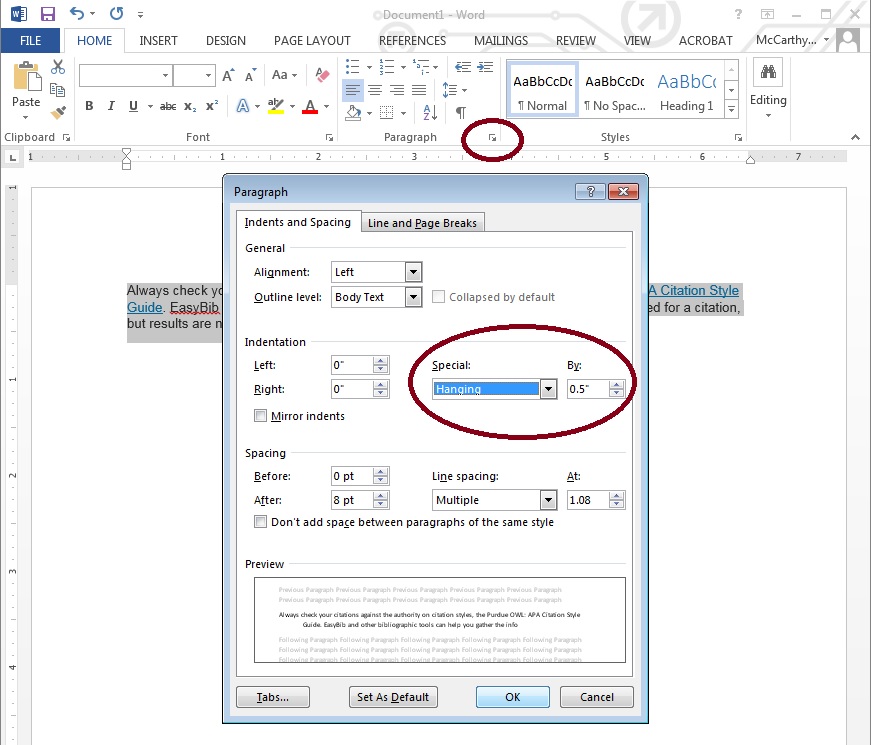
APA style covers both in-text citations (when you tell your reader where a particular piece of information or quote came from) and the list of references at the end of the paper. This page has help with both of these types of citations. If you want more examples, we also have a separate guide just for APA format, or see the many examples from Purdue OWL.
(APA style covers more than just how to format citations. It also has guidance on how to avoid sexist or racist language, and on how to talk about intersectionality, including age, social class, and disability. Those issues may not come up in for this course, but they might - and there's good information on that page.)
There are several ways to write an in-text citation in APA Style. Which one to use depends on what works best with your sentences. Here are examples from Purdue OWL about in text citations:
If you are directly quoting from a work, you will need to include the author, year of publication, and page number for the reference (preceded by "p." for a single page and “pp.” for a span of multiple pages, with the page numbers separated by an en dash). If you're quoting a webpage or online article without page numbers, use n.p. (the abbreviation for "no page number").
You can introduce the quotation with a signal phrase that includes the author's last name followed by the date of publication in parentheses.
According to Jones (1998), "students often had difficulty using APA style, especially when it was their first time" (p. 199).
Jones (1998) found "students often had difficulty using APA style" (p. 199); what implications does this have for teachers?
If you do not include the author’s name in the text of the sentence, place the author's last name, the year of publication, and the page number in parentheses after the quotation.
She stated, "Students often had difficulty using APA style" (Jones, 1998, p. 199), but she did not offer an explanation as to why.
When you use outside sources, you will need to create a References page that tells your reader all the information they need to find the source themselves if they want to.
Sources are listed in alphabetical order, according to the author's last (family) name. (If no author is credited, alphabetize according to the title.)
For more information about creating a Reference list, see Purdue OWL. There you will find examples of how to cite many different types of sources.
In APA format, each entry in the References list uses a hanging indent - that is, the citation starts at the left margin but if there is more than one line in a citation, those are indented (see the example above).
To do this, create a hanging indent in a Microsoft Word document. Go to Paragraph -> Indents and Spacing -> Indentation -> Special -> Hanging. See the illustration below.

As shown in the examples above, when quoting someone's exact words, the quotation is set apart with " " to make it clear to your readers which are your words and which came from another author.
When a passage you wish to quote includes a third person's words, use single quotation marks ( ' ' ) around that other author's words, nested inside the double quotation marks " ". For example:
Davis (2021) notes that the cause of "the gray whale die-off remains inconclusive. 'There’s a whole gamut of things that could occur when we have things come to shore,' says Justin Viezbicke, the California Stranding Coordinator for NOAA."
However, if a quotation is 40 words or longer, APA Style makes it easier on the readers (but a bit more complicated for authors) by eliminating the " " around the whole quotation; instead the entire quoted passage is indented 5 spaces. In that case, only third-party quotes get double quotation marks ( " " ), as in this example:
Still, the reason for the gray whale die-off remains inconclusive. "There’s a whole gamut of things that could occur when we have things come to shore," says Justin Viezbicke, the California Stranding Coordinator for NOAA. "Most of these animals are nearshore costal species and so when they do come ashore they’re providing this opportunity to learn what’s happening out there." (Davis, 2021)
In-text citations are not scary!
PowerPoint presentations on different aspects of APA style.
PowerPoint presentation on how to cite a journal article from a library database.
Presentation on the steps for citing a website and what to do with missing information.
How to create in-text citations in APA.
You'll find explanations of which details are needed in the Reference list for different types of publications in --